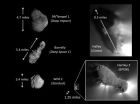Our normal genetics may influence cancer growth, too
2010-11-11
(Press-News.org) COLUMBUS, Ohio – The genes we possess not only determine the color of our eyes and hair and how our bodies grow, they might also influence the changes that occur in tumors when we develop cancer.
A study by researchers at the Ohio State University Comprehensive Cancer Center-Arthur G. James Cancer Hospital and Richard J. Solove Research Institute (OSUCCC – James) suggests that our normal genetic background – the genetic variations that we inherit – contributes to the kinds of DNA changes that occur in tumor cells as cancer develops.
The researchers compared multiple independent tumors from people with a form of skin cancer called squamous cell carcinoma (SCC) for losses and gains of DNA in tumor cells. They found that the pattern of these changes is quite similar in tumors from the same person but quite different in tumors from different individuals.
The findings, published in a recent issue of PLoS Genetics, may offer a new way to identify individuals at greater risk for developing cancer, the researchers say.
"Our data strongly support the idea that an individual's normal genetic constitution can strongly influence the genetic changes that occur when a person develops cancer," says study leader Amanda Toland, assistant professor of medicine and a specialist in the genetics of cancer susceptibility at the OSUCCC – James.
"They may also provide another strategy to identify genetic variations within healthy individuals that may increase their odds of developing cancer," she adds.
Toland and her collaborators analyzed 222 SCC tumors from 135 organ transplant recipients, who as a group are 65 to 250 times more likely to develop SCC than people in the general population. The researchers examined three or more separate tumors from 25 of these individuals.
They compared the genetic profiles of tumors from the same individual with those from other individuals for DNA copy number changes.
They found that the changes in SCCs from the same patient were statistically similar but significantly different when compared with other patients. They also found that in some cases a particular kind of genetic change is preferentially selected in tumors from the same individual.
"Overall," Toland says, "our findings provide strong evidence that an individual's genetic background plays a key role in driving the changes that occur in tumors during cancer development."
INFORMATION:
Funding from the National Institute of Arthritis and Musculoskeletal and Skin Diseases and the American Cancer Society supported this research.
Other researchers involved in this study were Amy M. Dworkin, Dawn C. Allain and
O. Hans Iwenofu of Ohio State University; Katie Ridd, Ritu Roy and Boris C. Bastian of University of California San Francisco; and Dianne Bautista, Singapore Clinical Research Institute, Singapore.
ELSE PRESS RELEASES FROM THIS DATE:
2010-11-11
A novel project set in a rural community near Rochester, N.Y., to screen elderly people for unmet needs showed that, indeed, there is a great opportunity to match older adults with professional assistance. This new model of care for rural-dwelling adults is described this month in the Journal of the American Geriatrics Society.
The University of Rochester Medical Center, Livingston County Department of Health and Office for the Aging, and the Genesee Valley Health Partnership collaborated to create this program, called Livingston Help for Seniors.
In one instance, ...
2010-11-11
Despite lack of evidence about bed rest's effectiveness, doctors annually prescribe it for roughly 1 million pregnant women to delay preterm births.
Judith Maloni, professor at the Frances Payne Bolton School of Nursing at Case Western Reserve University, said a comprehensive review of more than 70 evidence-based research articles challenges whether this is healthy for mothers — or their babies.
She makes her report in the article, "Antepartum Bed Rest for Pregnancy Complications: Efficacy and Safety for Preventing Preterm Birth," in the special women's health issue ...
2010-11-11
CINCINNATI—It's no surprise that being a physician is a very stressful job and carries a lot of responsibility with it.
But two new studies from researchers at the University of Cincinnati (UC) indicate that the stressors arising from work in the clinic, where physicians are seeing patients one-on-one, can effectively be measured with hopes of improving patient care and physician job satisfaction.
Ronnie Horner, PhD, and C. Jeff Jacobson, PhD, both researchers in the department of public health sciences, say their studies, published in online editions of the journal ...
2010-11-11
An estimated 26 million people, 13% of the United States population, are living with Chronic Kidney Disease (CKD), and this number continues to grow. If current trends continue, there will not be enough doctors to serve this expanding patient population.
To help address this crisis, the American Society of Nephrology (ASN) is convening a Summit on the Nephrology Workforce during its upcoming ASN Renal Week 2010 in Denver, Colorado, on November 17. Participants will discuss this crisis, its implications, and strategies to increase the number of kidney disease doctors in ...
2010-11-11
The Halpin Foundation and the American Society of Nephrology (ASN) proudly highlight the research advances in membranous nephropathy made possible by The Halpin Foundation-ASN Research Grant, created to help young faculty develop independent research careers. This award provides recipients transition funding toward successful application for an NIH RO1 grant.
Elena Torban, PhD (McGill University Faculty of Medicine), the 2008 recipient of The Halpin Foundation-ASN Research Grant, recently explained, "The generous financial two-year support provided by The Halpin Foundation ...
2010-11-11
COLUMBIA, Mo. ¬— Underage and heavy drinking on college campuses continue to be issues for college administrators. While some campuses, such as the University of Missouri, have made strides in efforts to reduce heavy drinking on campus, administrators are continually trying to educate students about the risks of excessive drinking. Now, two MU psychologists have found that students who viewed images of beer cans packaged and displayed in university colors believed that drinking beer was less dangerous than those students who saw images of regular beer cans.
"In this research, ...
2010-11-11
A team of international researchers led by physicists in the University of Minnesota's College of Science and Engineering have made a significant breakthrough in an effort to understand the phenomenon of high-temperature superconductivity in complex copper-oxides—one of the most studied scientific topics in history.
The University of Minnesota researchers and their international colleagues from Germany, France and China report the discovery of a novel type of magnetic wave involving oxygen atoms. The new findings could have implications for improving superconducting ...
2010-11-11
WHAT:
Newly published research by scientists at the National Institute of Allergy and Infectious Diseases, part of the National Institutes of Health, sheds light on a poorly understood, acute illness called Immune Reconstitution Inflammatory Syndrome (IRIS) that develops in some HIV-infected individuals soon after they begin antiretroviral therapy.
IRIS affects certain HIV-infected individuals whose immune systems are heavily damaged by the virus and who have a treated or undiagnosed AIDS-associated infection. When these individuals start antiretroviral therapy and ...
2010-11-11
Like a cosmic light bulb on a dimmer switch, Saturn emitted gradually less energy each year from 2005 to 2009, according to observations by NASA's Cassini spacecraft.
But unlike an ordinary bulb, Saturn's southern hemisphere consistently emitted more energy than its northern one. On top of that, energy levels changed with the seasons and differed from the last time a spacecraft visited in the early 1980s. These never-before-seen trends came from an analysis of comprehensive data from the Composite Infrared Spectrometer (CIRS), an instrument built by NASA's Goddard Space ...
2010-11-11
COLLEGE PARK, Md. – One of the biggest comet findings coming out of the amazing images and data taken by the University of Maryland-led EPOXI mission as it zipped past comet Hartley 2 last week is that dry ice is the 'jet' fuel for this comet and perhaps many others.
Images from the flyby show spectacular jets of gas and particles bursting from many distinct spots on the surface of the comet. This is the first time images of a comet have been sharp enough to allow scientists to link jets of dust and gas with specific surface features. Analysis of the spectral signatures ...
LAST 30 PRESS RELEASES:
[Press-News.org] Our normal genetics may influence cancer growth, too

